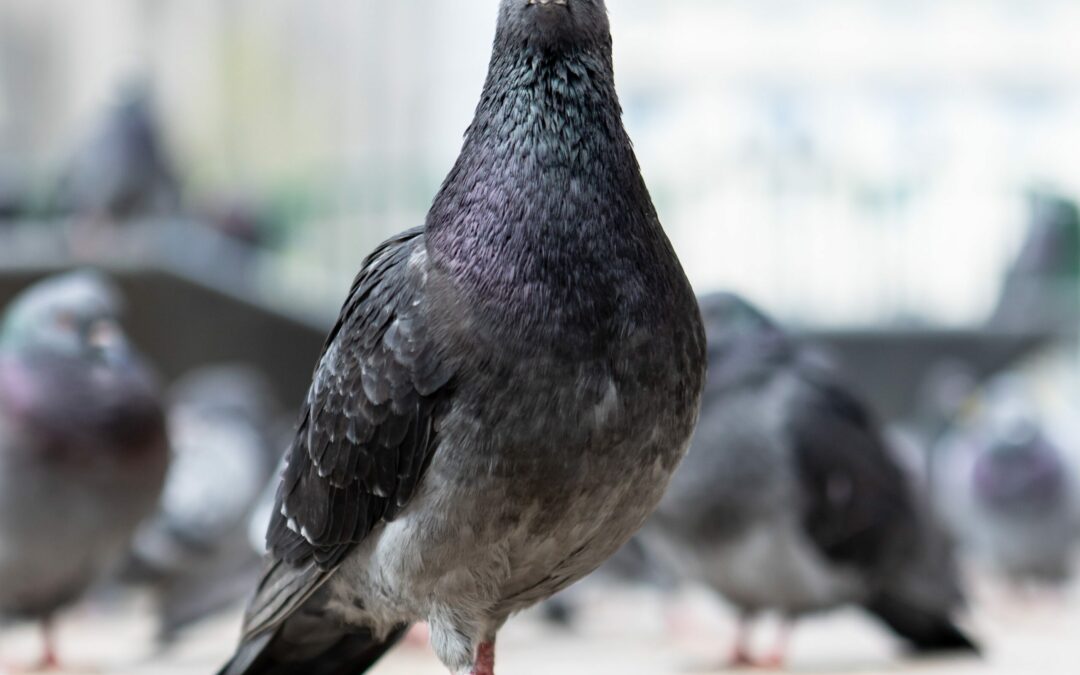
by Pigeon Patrol | Jun 8, 2025 | Bird Spikes, Pigeon Predators, Pigeon Spikes, Pigeons in the News
The steps of City Hall, once a symbol of civic pride, are now stained with something far less noble—pigeon droppings. A growing population of urban pigeons has turned the historic building into a nesting ground and bathroom, much to the frustration of city workers and residents.
“It’s absolutely disgusting,” said Angela Simmons, a clerk at the records office. “Every morning, we have to dodge piles of droppings just to get to the front door. Some days I have to bring a change of shoes.”
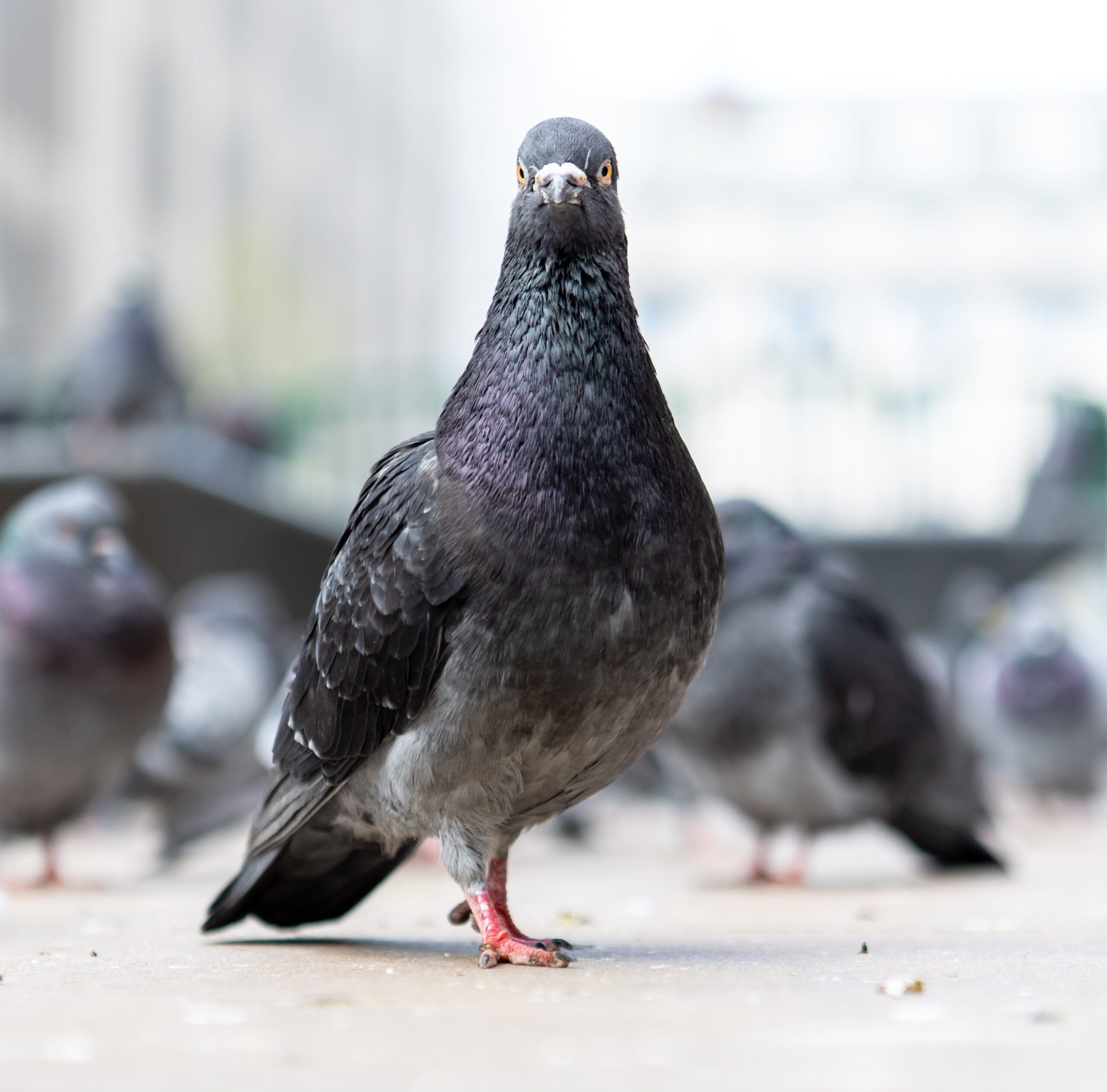
A closeup shot of a Feral pigeon in a city
The Department of Public Health has issued a warning about potential respiratory illnesses associated with dried pigeon feces, including histoplasmosis and cryptococcosis, both of which can cause serious lung infections.
Maintenance crews are power-washing the building’s steps twice a week, but it hasn’t been enough. “We’re just chasing the problem,” said Facilities Manager Larry Cho. “Until we deal with the birds themselves, we’ll keep mopping up after them.”
City Council is expected to vote next Tuesday on a proposed ordinance that would fund humane deterrents such as bird netting, sloped ledges, and the installation of owl decoys.
Pigeon Patrol Products & Services is the leading manufacturer and distributor of bird deterrent (control) products in Canada. Pigeon Patrol products have solved pest bird problems in industrial, commercial, and residential settings since 2000, by using safe and humane bird deterrents with only bird and animal -friendly solutions. At Pigeon Patrol, we manufacture and offer a variety of bird deterrents, ranging from Ultra-flex Bird Spikes with UV protection, Bird Netting, 4-S Bird Gel and the best Ultrasonic and audible sound devices on the market today.
Best Types of Pigeon Repellent
- Bird Spikes– Pigeons can’t land on surfaces with bird spikes—perfect for ledges, sills, signs, and fences.
Shop Bird Spikes: https://www.pigeonpatrol.ca/bird-spikes/
- Bird Sound Deterrents / Ultrasonic Repellers– Emit high-frequency sound to drive pigeons away without harming them.
Browse Ultrasonic Bird Repellers: https://www.pigeonpatrol.ca/bird-repeller/
- Pigeon Netting– Blocks pigeons from accessing nesting zones permanently.
See Pigeon Netting: https://www.pigeonpatrol.ca/bird-netting/
Canada’s top wholesaler for bird deterrent products for twelve consecutive years.
Contact us at 1- 877– 4– NO-BIRD, (604) 585-9279 or visit our website at https://www.pigeonpatrol.ca/
Bird Gone, Pigeon Gone, Pigeon problems, pigeon spikes, 1-877-4NO-BIRD, 4-S Gel, Bird Control, Pigeon Control, bird repellent, Bird Spikes, sonic bird repellent, stainless steel bird spikes, bird spikes Vancouver, Ultra Sonic Bird Control, Bird Netting, Plastic Bird Spikes, Canada bird spike deterrents, Pigeon Pests, B Gone Pigeon, Pigeon Patrol, pest controller, pest control operator, pest control technician, Pigeon Control Products, humane pigeon spikes, pigeon deterrents, pigeon traps, Pigeon repellents, Sound & Laser Deterrents, wildlife control, raccoon, skunk, squirrel deterrent, De-Fence Spikes, Dragons Den, Pigeon, Pigeon Patrol, Pigeons Roosting, Vancouver Pigeon Control, Bird Spikes, Bird Control, Bird Deterrent, Pigeon Deterrent, Surrey Pigeon Control, Pest, Seagull deterrent Vancouver Pigeon Blog, Birds Inside Home De-fence, Pigeon Nesting, Bird Droppings, Pigeon Dropping, woodpecker control, Keep The Birds Away, Birds/rats, seagull, pigeon, woodpecker, dove, sparrow, pidgeon control, pidgeon problem, pidgeon control, flying rats, pigeon Problems, bird netting, bird gel, bird spray, bird nails, bird guard, Pigeon control, Bird deterrents, Pigeon deterrents, Bird control, solutions, Pigeon prevention, Pigeon repellent, Bird proofing, Pest bird management, Pigeon spikes, Bird netting, Humane bird control, Bird exclusion, Urban bird control, Anti-roosting devices, Pigeon removal, Bird barriers
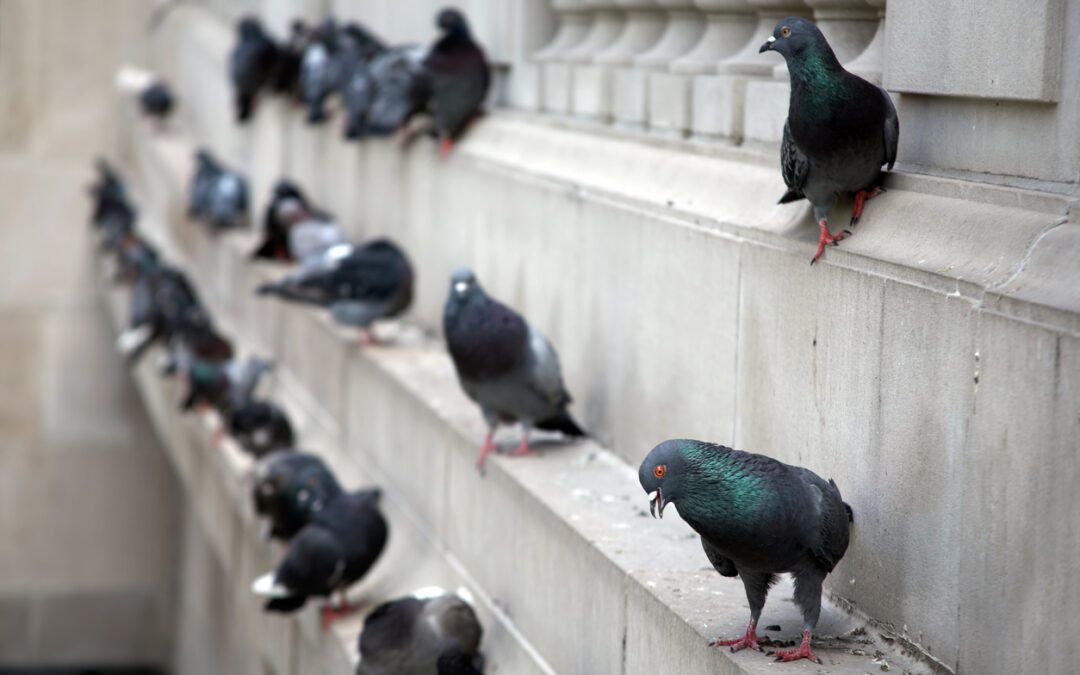
by Pigeon Patrol | Oct 15, 2024 | Bird Netting, Pigeon Droppings, Pigeon Patrol's Services, Pigeon Predators
More than 20 years ago, after a boozy bachelor party, three of us were walking across the small park at the intersection of State and Rush Streets. This, like many other parks large and small, is a place where pigeons congregate. Without a word of warning or “Hey, watch this,” the bachelor took a couple of quick steps and kicked an unsuspecting pigeon into the air. I saw the pigeon land with a thud 20 feet away but before I could say to the bachelor, “Why’d you kill that pigeon?” I watched in amazement as the pigeon shook its little head, got up on its skinny legs and went about its business. And I thought, “What a tough little bird.”
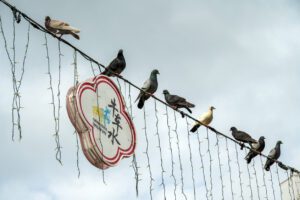
I didn’t give pigeons more thought until a few weeks ago when artist Tony Fitzpatrick–whose previous subjects in the Magazine have included fighting dogs, boxers, snakes and flowers–showed me his pigeon pictures. Here they are on this page and in my head’s a question: What do pigeons deserve? To be pitied, praised or punted?
There is no doubt that pigeons are the most urban of birds, the avian equivalent of squirrels or traffic jams; facts of city living to be either tolerated or complained about.
But listening to Megan Ross, curator of birds at Lincoln Park Zoo, talk about pigeons is to gain a new appreciation of them. “The species does get a bad rap,” she says. “But it is a fascinating species, if one takes the time to look.”
She points out that there are some 300 species of pigeons and doves. “What we commonly refer to in Chicago as a pigeon is actually a rock dove,” she says. Look closely and you will see that a pigeon is not just a dull gray mass, but a bird of 10,000 feathers, some of them bronze, pink, white and green. (Seriously, just take a look.) Watch them fly and you will also see what Ross describes as “fun flight patterns.” And, she adds, “They also have a nice courtship display.”
As well they should, since pigeons, it may surprise you to know, mate for life. Not only that, but male pigeons have the ability to lactate, producing milk for the babies just as females do.
Admittedly, when pigeons gather in groups, as they mostly seem to, they can exude the quiet menace of a gang. One almost expects to see some of them smoking cigarettes or spitting on the sidewalk.
“Rock doves are very docile birds,” says Ross. “They gather in groups not to intimidate people but as a protection against predators, such as falcons or raccoons. There is a certain safety in numbers.”
But their most common and persistent enemy is us. Besides various eradication efforts designed to limit their numbers, pigeons face determined campaigns by businesses to chase them away. Some even install fake owls on building ledges or set up loudspeakers that periodically emit terrible screeching, hawklike sounds in outdoor parking lots in an attempt to keep the CEO’s Jaguar clean.
“Many people are turned off by the fact that the birds poop,” says Ross.
This was not always the case. That people are turned off, I mean. In the 18th Century, King George I of England decreed all pigeon droppings to be property of the Crown. He even put guards at sites where the birds perched to enforce his edict. He was no birdbrain. There was a practical reason for his order: Pigeon manure was used in making gunpowder.
But if the birds have thus unknowingly contributed to the taking of lives, they have also done their bit to save them. With the ability to beat their wings up to 10 times a second, maintain a heart rate of 600 beats per minute for up to 16 hours without rest and fly as fast as 60 m.p.h., pigeons are the extreme athletes of the air.
In World War I, a homing pigeon named “Cher Ami” finished his distinguished career by delivering, while wounded, a vital message: the location of the famous “Lost Battalion,” thereby saving some 200 human lives. In WWII, a homing pigeon named “GI Joe” saved more than 1,000 allied soldiers’ lives in a single mission.
Who knows if Chicago pigeons would be up to such valorous deeds? But they are tough characters.
They do not migrate, as do more sensible species, and take the full brunt of Chicago winters. Unlike the rest of us, they do not whine about the wind chill. They seem capable of eating almost anything, from popcorn in the parks to abandoned pizza slices, old hamburger buns to cotton candy. “They have, shall we say, a hearty digestive system,” says Ross.
They don’t seem to be at all insecure about their looks, though people vastly prefer spunky sparrows.
They appear to be fearless, not only when confronted by the attacks from businesses but from individuals. Many little kids like to chase them. Older kids try to hit them with rocks or kick them. Some adults hunt and kill them for food. Though we were unable to catch any of these folks in the act of hunting, cooking or eating, the Internet is filled with recipes for pigeon.
All this, and pigeons can still live to be more than 30 years old.
It’s so easy to take everyday things for granted. When was the last time you watched a river or stream flow, looked up at a building’s decorative elements, scooped up a handful of sand or dirt or asked the name of your local Streetwise vendor?
So, why not give pigeons another look? Start with the ones fashioned by Fitzpatrick and then move on to the real things, to the resilient birds with which you share the sidewalks and park benches.
Pigeon Patrol Products & Services is the leading manufacturer and distributor of bird deterrent (control) products in Canada. Pigeon Patrol products have solved pest bird problems in industrial, commercial, and residential settings since 2000, by using safe and humane bird deterrents with only bird and animal -friendly solutions. At Pigeon Patrol, we manufacture and offer a variety of bird deterrents, ranging from Ultra-flex Bird Spikes with UV protection, Bird Netting, 4-S Bird Gel and the best Ultrasonic and audible sound devices on the market today.
Canada’s top wholesaler for bird deterrent products for twelve consecutive years.
Contact us at 1- 877– 4– NO-BIRD, (604) 585-9279 or visit our website at https://www.pigeonpatrol.ca/
Bird Gone, Pigeon Gone, Pigeon problems, pigeon spikes, 1-877-4NO-BIRD, 4-S Gel, Bird Control, Pigeon Control, bird repellent, Bird Spikes, sonic bird repellent, stainless steel bird spikes, bird spikes Vancouver, Ultra Sonic Bird Control, Bird Netting, Plastic Bird Spikes, Canada bird spike deterrents, Pigeon Pests, B Gone Pigeon, Pigeon Patrol, pest controller, pest control operator, pest control technician, Pigeon Control Products, humane pigeon spikes, pigeon deterrents, pigeon traps, Pigeon repellents, Sound & Laser Deterrents, wildlife control, raccoon, skunk, squirrel deterrent, De-Fence Spikes, Dragons Den, Pigeon, Pigeon Patrol, Pigeons Roosting, Vancouver Pigeon Control, Bird Spikes, Bird Control, Bird Deterrent, Pigeon Deterrent, Surrey Pigeon Control, Pest, Seagull deterrent Vancouver Pigeon Blog, Birds Inside Home De-fence, Pigeon Nesting, Bird Droppings, Pigeon Dropping, woodpecker control, Keep The Birds Away, Birds/rats, seagull, pigeon, woodpecker, dove, sparrow, pidgeon control, pidgeon problem, pidgeon control, flying rats, pigeon Problems, bird netting, bird gel, bird spray, bird nails, bird guard, Pigeon control, Bird deterrents, Pigeon deterrents, Bird control, solutions, Pigeon prevention, Pigeon repellent, Bird proofing, Pest bird management, Pigeon spikes, Bird netting, Humane bird control, Bird exclusion, Urban bird control, Anti-roosting devices, Pigeon removal, Bird barriers
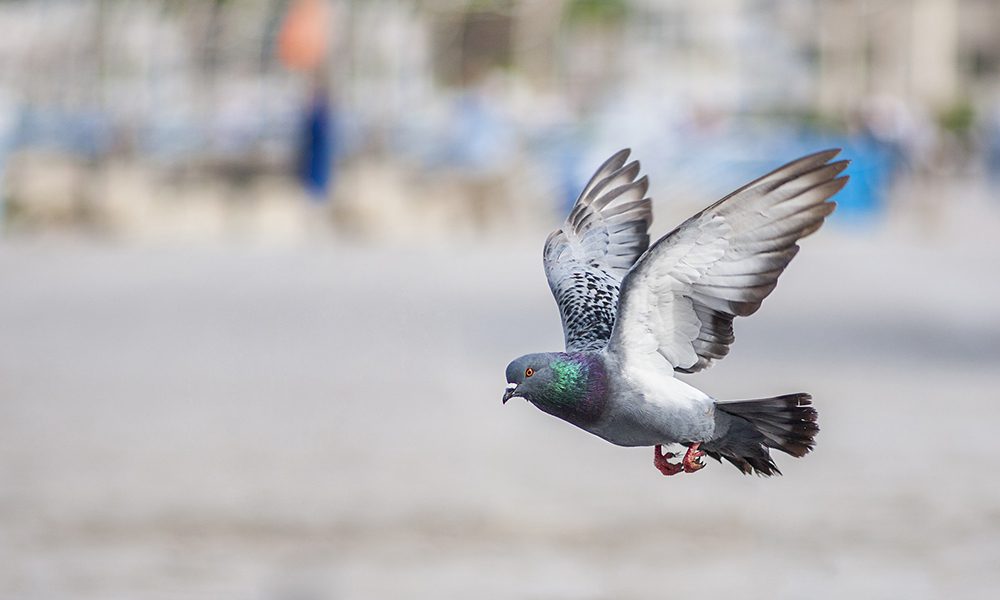
by Pigeon Patrol | Oct 15, 2024 | Bird Netting, Bird Spike, Pigeon Patrol's Services, Pigeon Predators, Pigeon Spikes
Ah, the one-legged pigeon of Ryerson — a famous figure on campus. Students and regular citizens alike fondly regale each other with stories of the deformed bird.
It’s been brought to my attention that the pigeon has gone missing. Is she dead? Was she eaten? Did she just pick up and leave, sick of all the attention she was getting at Ryerson?
Fret no more, my friends. I know the truth. Our one-legged pigeon is less of a circus freak and more of a noble revolutionary than any of us expected.
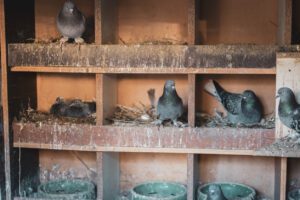
Pigeons and their chicks sitting on perches in farm countryside
The year was 2004. Facebook had just launched and everyone had flip phones. Outside the realm of human interest, however, a revolution was brewing.
The Pigeons’ Movement was one that had a substantial following, as all pigeons agreed that their resemblance to seagulls was systematically ruining their lives. They were sick and tired of being mistaken for the evil birds, who had garnered a bad reputation among the humans. As a result, a group of passionate individuals decided to take action.
Our one-legged pigeon was in the midst of a sit-in on the Kerr Hall Quad and was a leading figure of the Pigeons’ Movement. She was giving a speech (telepathically, of course) when an idea flashed across her mind. Why not make it clear that we are a force to be reckoned with?
As the birds communicated, it was decided that they would amputate a leg to demonstrate their seriousness. They wanted to be seen as unique, dammit. To them, this was the only solution. I won’t go into the grisly details of how exactly it was done, but I will say that it included some plastic knives and a lot of effort.
The movement yielded minimal results and soon, all of the dismembered pigeons lost touch. Of course, most of them died immediately, as they were unable to fend for themselves. Actually, all but one was deceased. She is the mastermind behind the imprudent plan. She is (you guessed it) the one-legged pigeon of Ryerson.
For years, she wandered around the campus, hoping to run into one of her old friends from her old life. Was the movement still kicking? Did she cut off her leg for no reason?
While humans laughed and took pictures of her, she cried. All of this suffering, because she wanted to fight the good fight.
Now, the question of where she disappeared to. The infamous one-legged pigeon is not, in fact, dead. She was discovered by some young activists, who then brought her underground to speak to a gathering of pigeons who wanted to revive the movement. She is respected there, and she is hopeful.
Expect to hear about the second wave of the Pigeons’ Movement. Expect to see some more deformed feathery friends hopping about. Let it be known that it all started with the one-legged pigeon of Ryerson.
Pigeon Patrol Products & Services is the leading manufacturer and distributor of bird deterrent (control) products in Canada. Pigeon Patrol products have solved pest bird problems in industrial, commercial, and residential settings since 2000, by using safe and humane bird deterrents with only bird and animal -friendly solutions. At Pigeon Patrol, we manufacture and offer a variety of bird deterrents, ranging from Ultra-flex Bird Spikes with UV protection, Bird Netting, 4-S Bird Gel and the best Ultrasonic and audible sound devices on the market today.
Canada’s top wholesaler for bird deterrent products for twelve consecutive years.
Contact us at 1- 877– 4– NO-BIRD, (604) 585-9279 or visit our website at https://www.pigeonpatrol.ca/
Bird Gone, Pigeon Gone, Pigeon problems, pigeon spikes, 1-877-4NO-BIRD, 4-S Gel, Bird Control, Pigeon Control, bird repellent, Bird Spikes, sonic bird repellent, stainless steel bird spikes, bird spikes Vancouver, Ultra Sonic Bird Control, Bird Netting, Plastic Bird Spikes, Canada bird spike deterrents, Pigeon Pests, B Gone Pigeon, Pigeon Patrol, pest controller, pest control operator, pest control technician, Pigeon Control Products, humane pigeon spikes, pigeon deterrents, pigeon traps, Pigeon repellents, Sound & Laser Deterrents, wildlife control, raccoon, skunk, squirrel deterrent, De-Fence Spikes, Dragons Den, Pigeon, Pigeon Patrol, Pigeons Roosting, Vancouver Pigeon Control, Bird Spikes, Bird Control, Bird Deterrent, Pigeon Deterrent, Surrey Pigeon Control, Pest, Seagull deterrent Vancouver Pigeon Blog, Birds Inside Home De-fence, Pigeon Nesting, Bird Droppings, Pigeon Dropping, woodpecker control, Keep The Birds Away, Birds/rats, seagull, pigeon, woodpecker, dove, sparrow, pidgeon control, pidgeon problem, pidgeon control, flying rats, pigeon Problems, bird netting, bird gel, bird spray, bird nails, bird guard, Pigeon control, Bird deterrents, Pigeon deterrents, Bird control, solutions, Pigeon prevention, Pigeon repellent, Bird proofing, Pest bird management, Pigeon spikes, Bird netting, Humane bird control, Bird exclusion, Urban bird control, Anti-roosting devices, Pigeon removal, Bird barriers
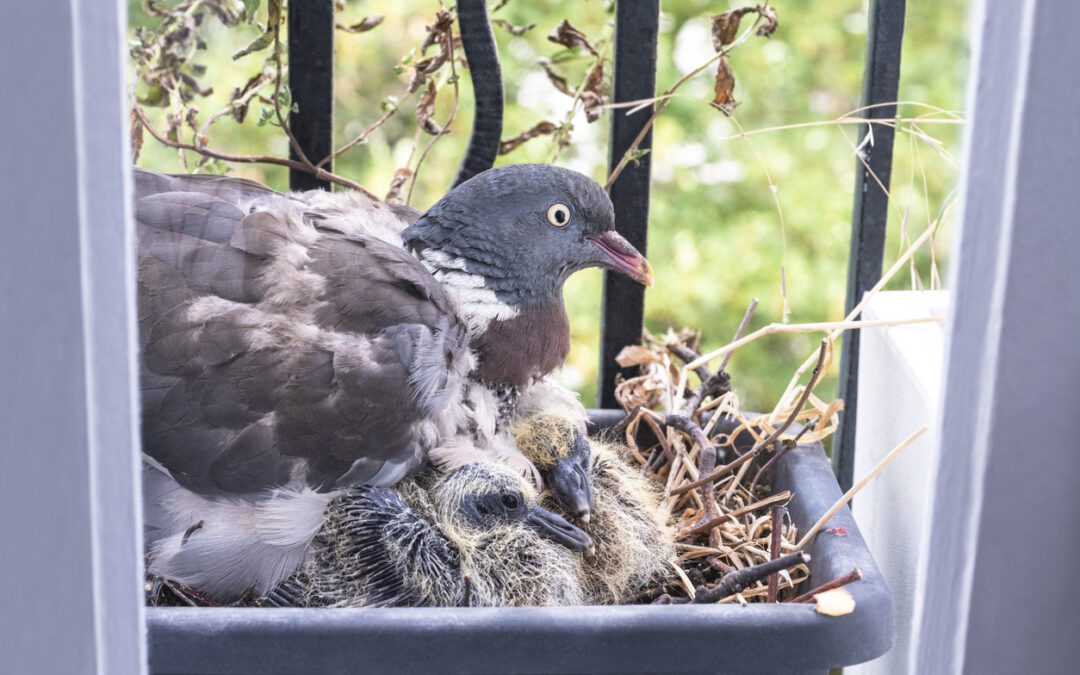
by Pigeon Patrol | Sep 25, 2024 | Bird Netting, Pigeon Droppings, Pigeon Predators, Pigeon Spikes
From sidewalks messed with droppings to gutters filled with feathers, birds aren’t always welcome in some public places. As beautiful as they can be individually, a large group of birds gathering atop a building or nesting in air vents can create a danger for themselves and the public.
BirdFlite wires keep large birds from gathering on a building’s ledge. Photos courtesy of Bird Barrier.
Bird Barrier Inc. of Carson, Calif., has developed several ways to keep birds off building ledges and awnings without harming them and with little to no visual impact.
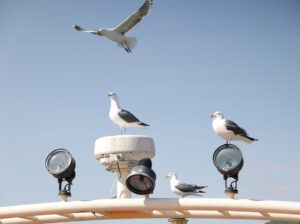
Four gulls observe from a sightseeing cruiser on Toyako, a caldera lake. Spring afternoon in Abuta District.
“You probably won’t even notice them,” says Monique Thorsell, marketing director for Bird Barrier, of the company’s various, and often strange-looking, bird deterrents.
Some of their products — such scarecrow-like screech owl decoys — have been used for years. Others — like the Daddi Long Legs with its many thin, wavy wires — look more like alien technology.
Though Bird Barriers has been around for eight years, Thorsell says some of its experts have been working in bird control for 20 years. “It has grown to be a very hot market in the last seven to eight years,” she said. As more development moves into the suburban areas, birds are finding their old nesting grounds are now covered in pavement. “We’re decreasing their natural habitat,” she says. “There are more conflicts being created.”
In recent years, increasing populations of Canadian Geese have left their mark — and droppings — on public parks and golf courses. Some are concerned the birds will destroy the landscaping and vegetation — others worry about diseases spreading through bird droppings.
In the city, birds create problems when they gather on rooftops where their feathers and droppings get into air vents, either circulating bacteria or causing mechanical problems. “You really want to keep birds off the air intake valves and air conditioning units,” Thorsell says. A lot of times they will clog up gutters, creating standing water that can wear down a roof.
The issue isn’t really with one or two birds hanging out on a ledge outside of the building, she says. “But if you have them in an area around the air conditioning unit or if you have a couple hundred birds on the building, you need to take a look at solving the issue.”
Contractors and homeowners can purchase products on Bird Barriers’ Web site. The company will provide teaching tools on which method will work best for the situation and how to install the product. “We don’t actually do the installs,” she said, but the company has trained more than 15,000 installers across the country.
Different products are recommended for different situations. The StealthNet is made of polyethylene twine and steel installation hardware, so it is difficult for the public to see from even a few feet away. Designed for all bird species and heavy use, the netting is attached to a pre-installed cable system. Though great for keeping birds off rooftops and air conditioning units, the installation of the StealthNet is rather involved.
Another product, Bird-Flite Spikes, comes in one-foot lengths and three different width configurations. The product is designed to keep birds the size of pigeons or larger off ledges, while leaving room for small songbirds. Made of stainless steel and polycarbonate, the base can be easily glued or screwed onto the surface.
Daddi Long Legs
The many wires of the Daddi Long Legs work to deter seagulls from landing on a boat.
The spider-like Daddi Long Legs is made of stainless steel and Delrin plastic. This product is often used on boats, atop streetlights and outdoor shade umbrellas to deter bigger birds from landing. “Not starlings or sparrows,” Thorsell says. “They can actually hang on the wires.”
The cost of installing a bird-deterrent system can vary depending on the product used and the extent of the project. “The homeowner that has a problem on their window ledge could spend $20 to $30,” she said, whereas keeping birds out of airport hangers could cost more than $100,000. “In general, the solution to the problem is anywhere from $500 to $2,500.”
At Seattle’s Key Arena, Bird Barrier products such as the Bird Flight and Bird Shock are used to keep birds away from and out of the building. While Bird Shock does generate an electric shock, Thorsell says it won’t actually harm the birds. “It sends a little conditioning shock, similar to a static-electricity shock,” she says.
In fact, the Humane Society and the Fund for Animals have endorsed Bird Barrier because the company provides non-harmful methods to deter birds. “We have the only completely humane product line in the business,” Thorsell says.
Here’s why some pigeons do backflips
At least five genes are involved in making parlor roller pigeons do backward somersaults
A brownish-red roller pigeon does backward somersaults from left to right across a white background.
Parlor roller pigeons like this one have a movement disorder that prevents them from flying. At least five genes are involved in making the birds do backward somersaults, new research suggests.
These roller pigeons come in two varieties: Flying rollers such as Birmingham rollers, which fly but do long tumbling runs toward the ground before resuming flight, and parlor rollers, which can’t fly but instead backflip along the ground. Many Persian poems say the pigeons perform the acrobatics because the birds are happy, but Samani says the truth is darker. “This is definitely a movement disorder, and it does not have any good aspects to it,” she says. The disorder is progressive, appearing soon after hatching and gradually getting worse until the birds can’t fly.
A smiling young woman, Atoosa Samani, with shoulder-length dark hair holds a small green bird with a yellow belly in her right hand. She is wearing a maroon coat and dark mauve stocking cap.
In addition to studying pigeon genetics, Atoosa Samani, pictured here holding a Wilson’s warbler, also volunteers with a bird banding group and enjoys bird watching. “I love birds,” she says. But she confesses that pigeons are her favorites.
Courtesy of A. Samani
Her colleagues confirmed backflipping is a recessive trait by breeding racing homer pigeons with parlor rollers; none of the hybrid offspring rolled. When hybrid birds were bred together, about 4 out of 10 of the offspring did somersaults when forced to fly, Samani said at the conference.
Samani used two different statistical methods to locate genes that make the pigeons tip tailfeather over teakettle. She found five large stretches of DNA containing hundreds of genes. But none of the genes in those areas had mutations that could account for the tumbling.
So she looked at gene activity in the birds’ brains and found nearly 2,000 genes that become either more or less active in the brains of parlor rollers than in two breeds of nonrolling pigeons.
Pigeon Patrol
Pigeon Patrol Products & Services is the leading manufacturer and distributor of bird deterrent (control) products in Canada. Pigeon Patrol products have solved pest bird problems in industrial, commercial, and residential settings since 2000, by using safe and humane bird deterrents with only bird and animal -friendly solutions. At Pigeon Patrol, we manufacture and offer a variety of bird deterrents, ranging from Ultra-flex Bird Spikes with UV protection, Bird Netting, 4-S Bird Gel and the best Ultrasonic and audible sound devices on the market today.
Canada’s top wholesaler for bird deterrent products for twelve consecutive years.
Contact us at 1- 877– 4– NO-BIRD, (604) 585-9279 or visit our website at https://www.pigeonpatrol.ca/
Bird Gone, Pigeon Gone, Pigeon problems, pigeon spikes, 1-877-4NO-BIRD, 4-S Gel, Bird Control, Pigeon Control, bird repellent, Bird Spikes, sonic bird repellent, stainless steel bird spikes, bird spikes Vancouver, Ultra Sonic Bird Control, Bird Netting, Plastic Bird Spikes, Canada bird spike deterrents, Pigeon Pests, B Gone Pigeon, Pigeon Patrol, pest controller, pest control operator, pest control technician, Pigeon Control Products, humane pigeon spikes, pigeon deterrents, pigeon traps, Pigeon repellents, Sound & Laser Deterrents, wildlife control, raccoon, skunk, squirrel deterrent, De-Fence Spikes, Dragons Den, Pigeon, Pigeon Patrol, Pigeons Roosting, Vancouver Pigeon Control, Bird Spikes, Bird Control, Bird Deterrent, Pigeon Deterrent, Surrey Pigeon Control, Pest, Seagull deterrent Vancouver Pigeon Blog, Birds Inside Home De-fence, Pigeon Nesting, Bird Droppings, Pigeon Dropping, woodpecker control, Keep The Birds Away, Birds/rats, seagull, pigeon, woodpecker, dove, sparrow, pidgeon control, pidgeon problem, pidgeon control, flying rats, pigeon Problems, bird netting, bird gel, bird spray, bird nails, bird guard, Pigeon control, Bird deterrents, Pigeon deterrents, Bird control, solutions, Pigeon prevention, Pigeon repellent, Bird proofing, Pest bird management, Pigeon spikes, Bird netting, Humane bird control, Bird exclusion, Urban bird control, Anti-roosting devices, Pigeon removal, Bird barriers

by Pigeon Patrol | Sep 25, 2024 | Bird Deterrent Products, Bird Netting, Pigeon Control, Pigeon Droppings, Pigeon Patrol's Services, Pigeon Predators
There are at least two potential consumer uses for lasers outdoors, pointing out stars in the sky and dispersing birds. This page discusses tips for deterring and dispersing birds.
Summary
LaserPointerSafety.com does not recommend that ordinary consumers use lasers to scare away unwanted birds. The right type of laser with a wide, low-powered beam is not readily available so there are too many potential safety problems for the birds, for the laser user, and for bystanders.
Also, there is a chance of accidentally having the beam be on or near an aircraft; this is illegal in many countries and jurisdictions. Finally, some species of birds may be only temporarily repelled by lasers; after a few minutes or within a day, studies indicate they will return.
Bird deterrence and dispersal
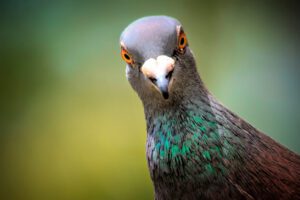
Domestic Pigeon looking at camera
Some consumers have asked about using lasers for bird dispersal.
A September 2003 U.S. Department of Agriculture publication, “Use of Lasers in Avian Dispersal” (available here or here) says that lasers are “safe and effective species-specific alternatives to pyrotechnics, shotguns, and other traditional avian dispersal tools.” A key phrase is “species-specific”. For example, a 2002 USDA study of crows (listed below) concluded that lasers do not work for more than a few minutes of dispersal, and are therefore not recommended for crows.
LaserPointerSafety.com believes there is a difference between serious, professional use, and consumers ordering possibly over-powered lasers off the Internet and simply waving them into trees and the sky. This is especially true in today’s environment where authorities are very sensitive to lasers being aimed into the air by ordinary citizens.
Our recommendation is that consumers should not use lasers against birds, especially Class 3B and Class 4 lasers (output power of 5 milliwatts or above). If a person feels they must try this, it should be done very carefully, with continuous monitoring of the sky so that aircraft are not accidentally targeted.
Pigeon Patrol
Pigeon Patrol Products & Services is the leading manufacturer and distributor of bird deterrent (control) products in Canada. Pigeon Patrol products have solved pest bird problems in industrial, commercial, and residential settings since 2000, by using safe and humane bird deterrents with only bird and animal -friendly solutions. At Pigeon Patrol, we manufacture and offer a variety of bird deterrents, ranging from Ultra-flex Bird Spikes with UV protection, Bird Netting, 4-S Bird Gel and the best Ultrasonic and audible sound devices on the market today.
Canada’s top wholesaler for bird deterrent products for twelve consecutive years.
Contact us at 1- 877– 4– NO-BIRD, (604) 585-9279 or visit our website at https://www.pigeonpatrol.ca/
Bird Gone, Pigeon Gone, Pigeon problems, pigeon spikes, 1-877-4NO-BIRD, 4-S Gel, Bird Control, Pigeon Control, bird repellent, Bird Spikes, sonic bird repellent, stainless steel bird spikes, bird spikes Vancouver, Ultra Sonic Bird Control, Bird Netting, Plastic Bird Spikes, Canada bird spike deterrents, Pigeon Pests, B Gone Pigeon, Pigeon Patrol, pest controller, pest control operator, pest control technician, Pigeon Control Products, humane pigeon spikes, pigeon deterrents, pigeon traps, Pigeon repellents, Sound & Laser Deterrents, wildlife control, raccoon, skunk, squirrel deterrent, De-Fence Spikes, Dragons Den, Pigeon, Pigeon Patrol, Pigeons Roosting, Vancouver Pigeon Control, Bird Spikes, Bird Control, Bird Deterrent, Pigeon Deterrent, Surrey Pigeon Control, Pest, Seagull deterrent Vancouver Pigeon Blog, Birds Inside Home De-fence, Pigeon Nesting, Bird Droppings, Pigeon Dropping, woodpecker control, Keep The Birds Away, Birds/rats, seagull, pigeon, woodpecker, dove, sparrow, pidgeon control, pidgeon problem, pidgeon control, flying rats, pigeon Problems, bird netting, bird gel, bird spray, bird nails, bird guard, Pigeon control, Bird deterrents, Pigeon deterrents, Bird control, solutions, Pigeon prevention, Pigeon repellent, Bird proofing, Pest bird management, Pigeon spikes, Bird netting, Humane bird control, Bird exclusion, Urban bird control, Anti-roosting devices, Pigeon removal, Bird barriers
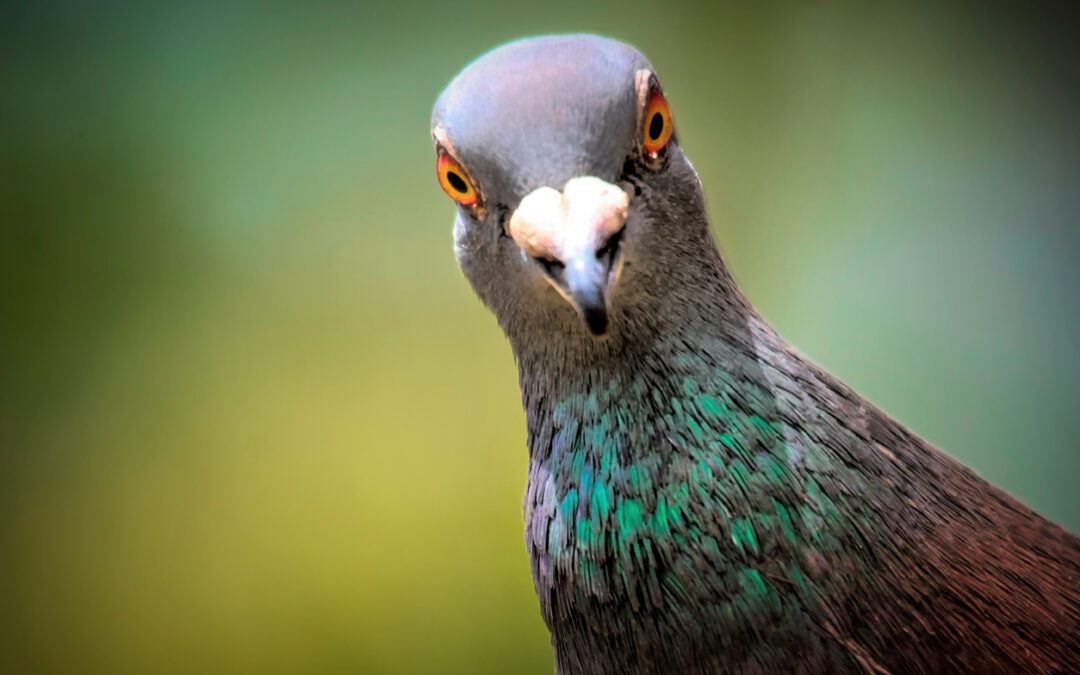
by Pigeon Patrol | Sep 19, 2024 | Bird Spike, Pigeon Predators, Pigeon Spikes
I LIKE pigeons. Their voices are soft and rhythmic. I have put up baskets for them in the front verandah and they live there quietly. They don’t ask for food – probably because they are fed at the roundabout near my house by compassionate people who come from far to drop grains for them every day. I have a bird table of rice and fruit so they can feed there whenever they want.
The Mumbai Municipal Commissioner has made it the feature of his (hopefully brief) tenure that he will get rid of the pigeons from Mumbai. Those who go looking for something to hate and often pick on pigeons should know what they have done for us humans over the years.
The first airmail using pigeons was established in 1896 in New Zealand and was known as the Pigeon-Gram Service. Their speed averaged 77.6 mph, only 40% slower than a modern aircraft. Each pigeon carried 5 messages and special Pigeon-Gram stamps were sold for each message carried.
In the First World War, pigeons were used extensively for carrying messages. German marksmen were deployed to shoot the birds down. Pigeons were carried in tanks and released through tiny portholes in the side. Mine-sweeping boats carried pigeons so that in the event of an attack by a U-boat, a pigeon could be released with a message confirming the exact location of the sinking boat, often resulting in the crew being saved. Seaplanes carried pigeons to relay urgent information about enemy movements. In the Second World War, pigeons were used in active service in Europe, India and Burma.
The last pigeon messaging service in the world was in Odisha called Orissa Police Carrier Pigeon Service and it disbanded in 2006 after 60 years of active service and 800 birds. Carrier pigeons had provided daily communications between Orissa’s 400 police stations across the state. They carried essential messages during two natural disasters: the massive cyclone in 1971 and the unprecedented floods in 1982. Their ability to fly in adverse weather conditions saved many human lives.
Read Also
Impressive Voter Turnout In J&K Shows People’s Strong Trust In Democracy: Amit Shah
Influence Of Social Media On Golf’s Popularity In Post-Pandemic World
In the 5th century BC the first network of pigeon messengers is thought to have been established in Assyria and Persia by Cyrus the Great. In 2000 BC they were carrying messages to warring groups in Mesopotamia. In 53 B.C they carried Hannibal’s dispatches. Julius Caesar used pigeons during the conquest of Gaul from 58 to 51 BC. Indian and Arab merchants used carrier pigeons when visiting China. At the first Olympic Games held in 776 BC, every athlete had a homing pigeon from his village. If he won his event, his would be the bird that carried the news home.
Between 63 BC – AD 21, the Greek geographer Strabo noted that pigeons flew between certain points along the Mediterranean coastline to carry messages of the arrival of fish shoals for waiting fishermen.
The news agency Reuters originally used pigeons to disseminate news in the 1840s. Paul Julius Reuter’s pigeons only stopped when the telegram was invented. In 1870 they carried messages throughout France during the siege of Paris.
In 1915, at the start of the First Great War, two Pigeon Corps were established on the Western Front, consisting of 15 pigeon stations each with 4 birds and a handler. The Pigeon Corps was so successful that further birds were recruited, and the service expanded considerably. By the end of the war the Pigeon Corps consisted of 400 men and 22,000 pigeons in 150 mobile lofts. Messages would be put into a small canister and then attached to the pigeon’s leg. The bird would be released and would return to its loft behind allied lines, sounding a bell to confirm that it had landed. Each airfield along the coast of England had its own loft so that pigeons could be dispatched with messages in the event of invasion. Bomber crews usually carried a pair of pigeons so that in the event that the plane was shot down, the birds could be released with details of the crash site.
These birds played a major role in the Intelligence Service in the First World War. They were sent to maintain contact with resistance movements across Europe. Fewer than 10% survived the shell fire, small arms fire, poison gas.
In 1940, 300 crates of pigeons were dropped into Enemy-occupied areas of Europe, each bird being packed into a box with food for 10 days. Instructions and a questionnaire were put in the box. If found by an ally, information about enemy movement could be put inside the container on the bird’s leg and the bird released to fly back. 16,544 pigeons were parachuted into occupied Europe during the Second Great War. Only 1,842 returned.
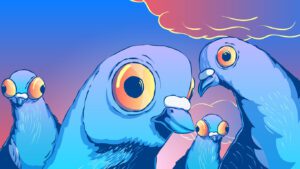
Hand-drawn funny cute illustration – Curious pigeons.
Over 1,00,000 British pigeons lost their lives in military service. Red Cock flew back a torpedoed trawler carrying the grid reference of the sinking boat and saving the crew. In October 1918, 500 men of the 77th Infantry were trapped in Argonne, France with no food or ammunition and being bombarded by their own side. The major sent the pigeon Cher Ami with a message for rescue. The bird was shot through the breast by enemy fire and fell to the ground. She got back into the air and flew 25 miles back to Division Headquarters in 25 minutes. The men were saved. Cher Ami had delivered the message despite having been shot through the breast, blinded in one eye and with a leg hanging by only a tendon. The Dickin medal is awarded to any animal that has distinguished itself through an act of bravery in wartime. Of the 55 medals awarded to date, pigeons have been recognized 32 times- much less than they deserve because they saved the lives of lakhs of people. The American and Australian Services also used pigeons extensively and had their own pigeon units operating indifferent countries. So did Burma (Myanmar) and India.
Some years ago, the Indian army captured a pigeon carrying a message from the Pakistan army.
Pigeons were used for aerial photography. A miniature camera was mounted to the bird’s breast via a canvass harness and the pigeon sent to areas of strategic importance to capture images. The films provided information about enemy troop movements and air bases. Information relating to exact positions of the V1 flying bomb site in Peenemunde in Germany was conveyed by pigeons – information that turned the tide of the war.
In 2004 an impressive memorial to commemorate all the animals and birds killed during wartime was erected in Hyde Park. Pigeons have been given pride of place in the sculpture with two pack mules in the foreground weighed down with munitions and cannon parts.
Pigeons more than any other animal have been man’s best friend in times of crisis. They give of themselves for a just a handful of grain. You need to repay your debt every day.
Pigeon Patrol
Pigeon Patrol Products & Services is the leading manufacturer and distributor of bird deterrent (control) products in Canada. Pigeon Patrol products have solved pest bird problems in industrial, commercial, and residential settings since 2000, by using safe and humane bird deterrents with only bird and animal -friendly solutions. At Pigeon Patrol, we manufacture and offer a variety of bird deterrents, ranging from Ultra-flex Bird Spikes with UV protection, Bird Netting, 4-S Bird Gel and the best Ultrasonic and audible sound devices on the market today.
Canada’s top wholesaler for bird deterrent products for twelve consecutive years.
Contact us at 1- 877– 4– NO-BIRD, (604) 585-9279 or visit our website at https://www.pigeonpatrol.ca/
Bird Gone, Pigeon Gone, Pigeon problems, pigeon spikes, 1-877-4NO-BIRD, 4-S Gel, Bird Control, Pigeon Control, bird repellent, Bird Spikes, sonic bird repellent, stainless steel bird spikes, bird spikes Vancouver, Ultra Sonic Bird Control, Bird Netting, Plastic Bird Spikes, Canada bird spike deterrents, Pigeon Pests, B Gone Pigeon, Pigeon Patrol, pest controller, pest control operator, pest control technician, Pigeon Control Products, humane pigeon spikes, pigeon deterrents, pigeon traps, Pigeon repellents, Sound & Laser Deterrents, wildlife control, raccoon, skunk, squirrel deterrent, De-Fence Spikes, Dragons Den, Pigeon, Pigeon Patrol, Pigeons Roosting, Vancouver Pigeon Control, Bird Spikes, Bird Control, Bird Deterrent, Pigeon Deterrent, Surrey Pigeon Control, Pest, Seagull deterrent Vancouver Pigeon Blog, Birds Inside Home De-fence, Pigeon Nesting, Bird Droppings, Pigeon Dropping, woodpecker control, Keep The Birds Away, Birds/rats, seagull, pigeon, woodpecker, dove, sparrow, pidgeon control, pidgeon problem, pidgeon control, flying rats, pigeon Problems, bird netting, bird gel, bird spray, bird nails, bird guard, Pigeon control, Bird deterrents, Pigeon deterrents, Bird control, solutions, Pigeon prevention, Pigeon repellent, Bird proofing, Pest bird management, Pigeon spikes, Bird netting, Humane bird control, Bird exclusion, Urban bird control, Anti-roosting devices, Pigeon removal, Bird barriers












